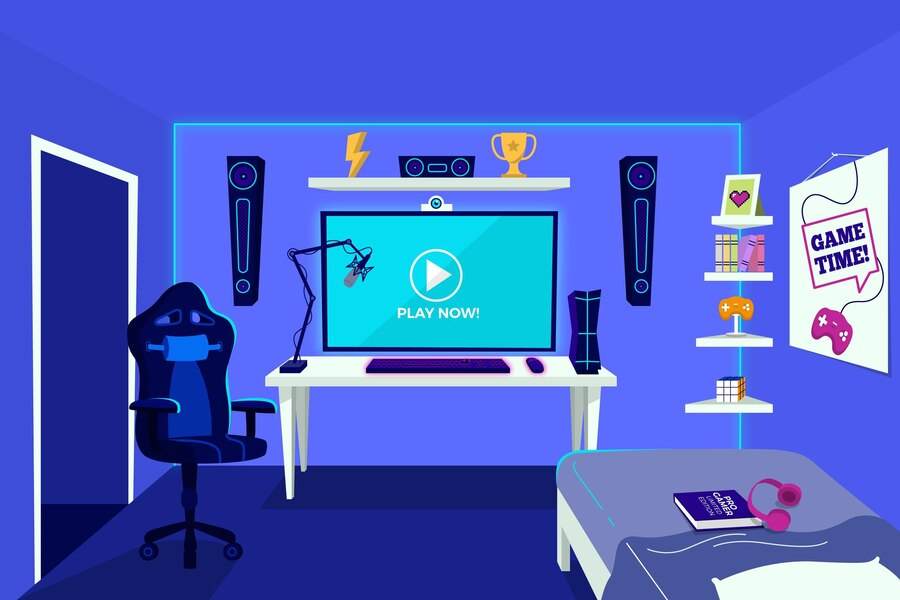How to Set Up the Perfect Gaming Station at Home

Are you ready to take your gaming to the next level? A dedicated gaming station can make all the difference in your comfort, performance and overall enjoyment. But with so many options and factors to consider, where do you even begin? Fear not, intrepid gamer – this guides you through everything you need to know to create the gaming setup of your dreams.
Step 1: Choose the Right Space
The first step to building your ultimate gaming station is deciding where to put it. You’ll want to choose a space that’s comfortable, convenient and conducive to long gaming sessions. Here are some factors to consider:
Size and Layout
Make sure you have enough room for all your gaming equipment, including your PC or console, monitor(s), keyboard, mouse, and any other peripherals. You’ll also want some extra space to move around and stretch during breaks. If possible, choose a room with a door you can close for privacy and noise reduction.
Lighting and Ambience
Proper lighting is crucial for reducing eye strain and creating a comfortable gaming environment. Avoid harsh overhead lights in favour of softer, diffused lighting. You can also use RGB light strips or gaming-themed lamps to add some ambience and personality to your space.
Ventilation and Temperature
Gaming equipment can generate a lot of heat, so good ventilation is key to preventing overheating and extending the life of your devices. Choose a room with good airflow, and consider investing in a fan or air conditioner for the hot summer months. Aim to keep the room temperature between 68-77°F (20-25°C) for optimal performance and comfort.
Noise and Distractions
If possible, choose a space away from high-traffic areas and noisy appliances like TVs or washing machines. You may also want to invest in some soundproofing materials like acoustic foam panels or heavy curtains to reduce outside noise and keep your gaming audio from disturbing others.
Step 2: Invest in a Quality Desk and Chair
Once you’ve chosen your space, it’s time to start filling it with the right furniture. A good desk and chair are the foundation of any gaming setup, so it’s worth investing in quality pieces that will keep you comfortable and supported for long gaming sessions.
Desks
Look for a desk that’s large enough to hold all your gaming equipment with some room to spare. A width of at least 48 inches (122 cm) is a good starting point. Consider a desk with built-in cable management to keep cords tidy, and look for sturdy construction that won’t wobble during intense gaming moments. Some popular options include:
- Standing desks: These desks can be adjusted to different heights, allowing you to alternate between sitting and standing throughout the day. Great for promoting better posture and circulation.
- L-shaped desks: These corner desks provide ample space for multiple monitors, speakers, and other peripherals. They also make efficient use of corner spaces in small rooms.
- Gaming-specific desks: These desks are designed with features like built-in mousepad surfaces, headset hooks, and even cup holders. They often have edgy, racing-inspired designs to match your gaming aesthetic.
Chairs
A good gaming chair should provide enough support to keep you comfortable for hours on end. Look for features like adjustable armrests, lumbar support, and a reclining backrest. The seat should be wide enough to accommodate your hips and thighs, and the material should be breathable to prevent sweating. Popular types include:
- Racing-style chairs: These chairs resemble the bucket seats found in sports cars, with high backs, winged shoulders and lots of bold colour options. They’re a popular choice for their cool factor and high adjustability.
- Ergonomic office chairs: These chairs prioritize function over form, with features like mesh backs, adjustable lumbar support, and waterfall seat edges to reduce pressure on your legs. A great choice if comfort is your top priority.
- Rockers and recliners: These laid-back chairs are perfect for console gaming in front of a TV. They often have built-in speakers, vibration motors and other immersive features. Just be careful not to fall asleep mid-game!
Step 3: Choose Your Gaming Hardware
Now for the fun part – picking out your gaming gear! The hardware you choose will depend on your budget, preferred gaming platform and performance needs. Here are the key components to consider:
PCs
If you’re a PC gamer, you’ll need a rig powerful enough to handle your favourite games at the settings and resolutions you want. Key specs to look at include:
- CPU: This is the brain of your PC. Look for a high clock speed (measured in GHz) and multiple cores for better performance. Popular gaming CPUs include the Intel Core i5, i7 and i9 series, and the AMD Ryzen 5, 7 and 9 series.
- GPU: The graphics card is what generates the images you see on screen. Look for a card with a high amount of VRAM (video memory) and a fast clock speed. NVIDIA’s RTX 30 series and AMD’s Radeon RX 6000 series are current top picks.
- RAM: Your system’s short-term memory. 16GB is the sweet spot for most gaming needs, but 32GB can help with multitasking and future-proofing.
- Storage: Look for a fast solid-state drive (SSD) for your operating system and favourite games, and a larger hard disk drive (HDD) for bulk media storage.
You can buy a pre-built gaming PC or laptop from brands like Alienware, Razer, ASUS ROG or MSI, or build your custom rig for more control over your components and budget.
Consoles
For a simpler plug-and-play experience, you can opt for a dedicated gaming console like the PlayStation 5, Xbox Series X/S or Nintendo Switch. These devices are optimized for gaming right out of the box, with no need to worry about component compatibility or driver updates. Just make sure you have the right cables and peripherals for your chosen platform.
Screens
Your screen is your window into the gaming world, so it’s worth splurging on a high-quality display. For PC gaming, look for a monitor with a fast refresh rate (120Hz or higher), low input lag, and a resolution of at least 1080p. Higher resolutions like 1440p or 4K will provide sharper visuals but require a more powerful GPU to run smoothly. You can also opt for an ultrawide monitor for a more immersive field of view, or a multi-monitor setup for enhanced multitasking and productivity.
For console gaming, you’ll typically be connecting to a TV. Look for a set with low input lag (ideally under 20ms), a fast refresh rate, and support for HDR and/or Dolby Vision for enhanced color and contrast. OLED TVs provide the best picture quality, but can be prone to image retention (“burn-in”) with static HUD elements.
Step 4: Accessorize and Personalize
Once you have your core components in place, it’s time to add the finishing touches that will truly make your gaming station feel like home. Here are some key accessories to consider:
Audio
Good audio is essential for immersing yourself in your games and communicating with teammates. For competitive gaming, a high-quality headset with a clear microphone is a must-have. Look for a model with a wide frequency response range, good noise isolation, and a comfortable fit for long sessions. Popular brands include HyperX, SteelSeries, Astro, and Sennheiser.
For a more cinematic experience, you can opt for a surround-sound speaker system or a soundbar. Just be mindful of your neighbours and housemates!
Peripherals
The right mouse, keyboard and controller can make a big difference in your gaming performance and enjoyment. For PC gaming, look for a mouse with a high DPI (dots per inch) sensor for precise aiming, customizable buttons for mapping in-game actions, and a comfortable ergonomic shape for your hand.
Mechanical keyboards are popular among gamers for their tactile feedback, durability and customization options. Look for a model with responsive key switches (Cherry MX, Razer, etc.), programmable RGB lighting, and sturdy build quality.
For console gaming, invest in a high-quality controller with responsive buttons, analogue sticks and triggers. The official controllers from Sony, Microsoft and Nintendo are always solid picks, but you can also find feature-rich options from third-party brands like Scuf, Razer and PowerA.
Décor
Finally, don’t forget to add some personal flair to your gaming space! Here are some ideas:
- Hang posters, artwork or shelves featuring your favourite games, characters or franchises
- Display your collection of game boxes, figurines or other memorabilia.
- Add some greenery with low-maintenance plants like succulents or snake plants.
- Use RGB lighting strips, Nanoleaf panels or smart bulbs to create custom lighting schemes that match your current game or mood.
- Incorporate geeky throw pillows, blankets or other cosy touches to make the space more inviting.
Remember, this is your oasis, so have fun and let your personality shine through!
Parting Words
Building the perfect gaming station is a labour of love. It may take some time, research and experimentation to get everything just right. But trust me – when you finally sit down to play in a space that’s truly your own, with gear that’s perfectly tailored to your needs and style, the effort will all be worth it.
So go forth, intrepid gamer, and create the battle station of your dreams! May your frame rates be high, your ping below, and your achievements be plentiful. Happy gaming!
